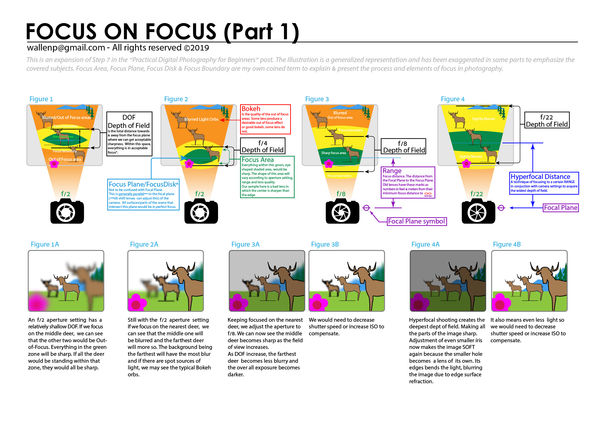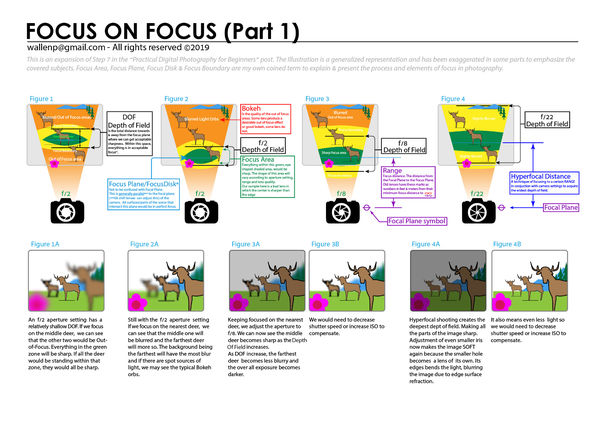Practical Digital Photography for Beginners - Focus on Focus
Sep 3, 2019 01:00:41 #
This is an expansion of Step 7 in the “Practical Digital Photography for Beginners” post. The Illustration is a generalized representation and has been exaggerated in some parts to emphasize the
covered subjects. Focus Area, Focus Plane, Focus Disk & Focus Boundary are my own coined term to explain & present the process and elements of focus in photography.
covered subjects. Focus Area, Focus Plane, Focus Disk & Focus Boundary are my own coined term to explain & present the process and elements of focus in photography.
Sep 3, 2019 04:10:06 #
I think your chart would be rather confusing for most beginners. Too much information all at once, including information which is better suited for a photographer with intermediate skills.
For example, why would a beginner need to know what markings are on an old lens? Or an explanation on what bokeh is? Or what a focal plane symbol looks like? Or how to recognize a bad lens? Or what surface refraction is? And some things just need to be simplified a little more so not to overwhelm the beginner, using a camera for the first time. For example, instead of "acceptable focus", just call it "in focus". Instead of talking about bokeh, just call it "out of focus".
For an instruction chart intended for beginners to be effective, it must be simple and avoid anything beyond the most essential information to get the beginner started. Always keep the target reader in mind.
For example, why would a beginner need to know what markings are on an old lens? Or an explanation on what bokeh is? Or what a focal plane symbol looks like? Or how to recognize a bad lens? Or what surface refraction is? And some things just need to be simplified a little more so not to overwhelm the beginner, using a camera for the first time. For example, instead of "acceptable focus", just call it "in focus". Instead of talking about bokeh, just call it "out of focus".
For an instruction chart intended for beginners to be effective, it must be simple and avoid anything beyond the most essential information to get the beginner started. Always keep the target reader in mind.
Sep 3, 2019 05:24:16 #
rook2c4 wrote:
I think your chart would be rather confusing for most beginners. Too much information all at once, including information which is better suited for a photographer with intermediate skills.
Sorry if it seems that way. It is an expansion of a previous post where details about Focus are being addressed.
https://www.uglyhedgehog.com/t-575239-1.html
I actually trimmed it down as "Part 1". Wait till you see part 2

rook2c4 wrote:
For example, why would a beginner need to know what markings are on an old lens? Or an explanation on what bokeh is?
Because bokeh is something a newbie will always read & hear about but seldom explained. Range is a part of the subject Focus, which is being discussed and being a marking they would see on old lenses makes it a good example to cite.
rook2c4 wrote:
Or what a focal plane symbol looks like? Or how to recognize a bad lens?
Just like the other, they are integral part of Focus so they need to be included and discussed. Also because just like Bokeh, Focal plane is something a lot of photographers get confused with. Many believe it is the focus point on the subject when it is where the image is focused in the sensor or the film.
As for bad lens, beginners are usually the one who have cheap bad lenses. Hence it is good information of correlating what they might see with the information on the chart.
rook2c4 wrote:
Or what surface refraction is?
That is grade school science. (almost)Everybody should know what refraction is and it is the most basic reason i can provide to tell why making the iris further smaller do not make the image better.
rook2c4 wrote:
And some things just need to be simplified a little more so not to overwhelm the beginner, using a camera for the first time. For example, instead of "acceptable focus", just call it "in focus". Instead of talking about bokeh, just call it "out of focus".
(In focus)Sharp focus Area & out of focus are there in the chart. Bokeh & acceptable focus are explanation call-outs. Both of are there.
Please note that "acceptable focus" is part of DOF and only a very slim part of that is in focus. Only those that intersect the Focus Disk/Focus Plane are actually in focus. Everything else is blurred from a lesser to greater degree.
rook2c4 wrote:
For an instruction chart intended for beginners to be effective, it must be simple and avoid anything beyond the most essential information to get the beginner started. Always keep the target reader in mind.
As stated, this is an expansion of a previous post. It is a little more in depth explanation of the previous subjects.
Jan 27, 2020 23:26:22 #
Wallen wrote:
This is an expansion of Step 7 in the “Practical Digital Photography for Beginners” post. The Illustration is a generalized representation and has been exaggerated in some parts to emphasize the
covered subjects. Focus Area, Focus Plane, Focus Disk & Focus Boundary are my own coined term to explain & present the process and elements of focus in photography.
covered subjects. Focus Area, Focus Plane, Focus Disk & Focus Boundary are my own coined term to explain & present the process and elements of focus in photography.
Corrigendum
a. In Figure 2, it should be f/2 not f/4
b. In Figure 3A, it should read as Depth Of Field not Field Of View (DOF not FOV)
.
Jan 28, 2020 08:44:51 #
Wallen wrote:
As stated, this is an expansion of a previous post. It is a little more in depth explanation of the previous subjects.
Just the fact that you have to explain what you mean to someone who has been around photography for a while, shows this is not ready for prime time where beginners are concerned. Your comment about what everybody should know further shows you are not inclined to help beginners.
IMHO

---
Jan 28, 2020 23:48:52 #
Bill_de wrote:
Just the fact that you have to explain what you mean to someone who has been around photography for a while, shows this is not ready for prime time where beginners are concerned. Your comment about what everybody should know further shows you are not inclined to help beginners.
IMHO
---
IMHO

---
I respect your opinion but unless you have read the first post to which this was a series to; https://www.uglyhedgehog.com/t-575239-1.html
and the grey colored text on top just below the title of the graphic,
it would be judging an ocean by looking at a raindrop feeding a stream.
It also seem that you skipped the first part of the paragraph. "It is grade school science"-hence "(almost) everyone should know what diffraction means". As you see, i am not pushing anything to anyone. I'm stating that it is supposed to be common knowledge since such is taught in grade school.
If someone see something they do not understand, a person who want to learn would ask and i would be more than happy to provide my best. Those who do not, challenges the idea, sometimes to push their own. Either way, it is proper to explain why i view things a certain way.
As for the inclination to help others, i have been a volunteer for most of my life. I've been a noob too, I wont bother to share my ideas if i do not intend to help.
Jan 29, 2020 15:33:54 #
It looks like a good chart but figure 4A states that hyperfocal makes all parts of the image sharp. With hyperfocal, everything from one-half the hyperfocal distance to infinity is in apparent focus. So if a hyperfocal calculator gives a distance of 20 feet, everything from 10 feet to infinity will be in apparent focus.
There may be a mistake in the last sentence under figure 4A. It says: "Its edges bends the light, blurring the image due to edge surface refraction." Refraction should be diffraction. Refraction occurs the when light is passing through a medium such as glass, water, and other materials
There may be a mistake in the last sentence under figure 4A. It says: "Its edges bends the light, blurring the image due to edge surface refraction." Refraction should be diffraction. Refraction occurs the when light is passing through a medium such as glass, water, and other materials
Feb 15, 2020 23:00:43 #
CO wrote:
It looks like a good chart but figure 4A states th... (show quote)
You are absolutely correct about refraction which is the bending of light through an object. It is supposed to be diffraction which is bending of light around an object. It was a misprint on my side.
As for the A4 statement; "all parts of the image sharp" is a general accepted assumption but in reality is really just the "best compromise" as having all distances sharp is not physically possible. You can actually see it on the chart that it merely put most of the areas in yellow-"acceptable focus".
If you want to reply, then register here. Registration is free and your account is created instantly, so you can post right away.




